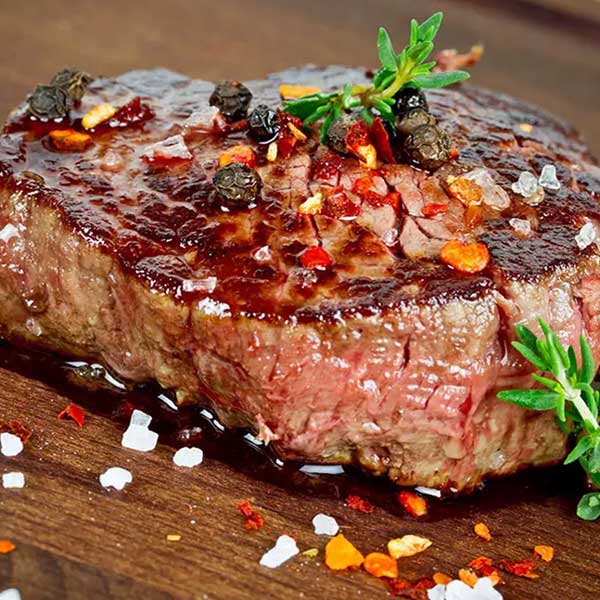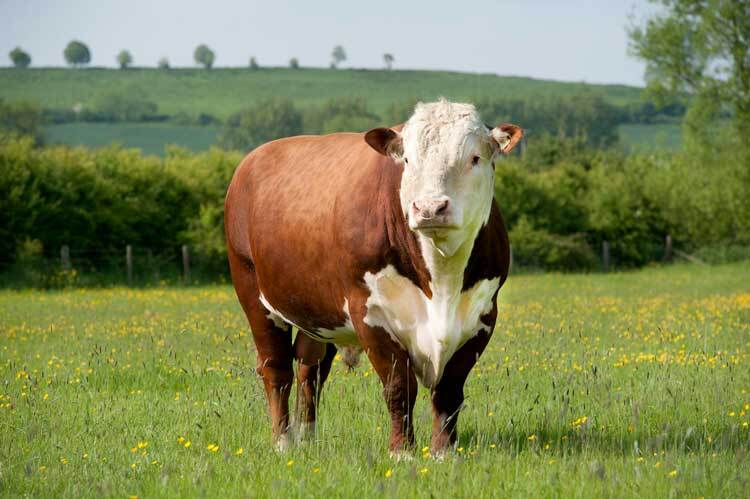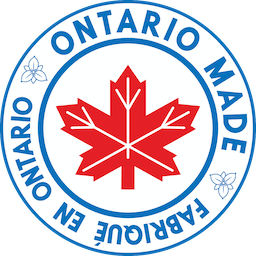Introduction
The Hereford breed is a heritage breed of beef cattle that has played an integral role in Canada’s beef industry for over a century. Herefords first came to Canada from England in the 1860s and were originally used as work oxen on farms and ranches across the Prairies.
However, it was not until the 1880s that Herefords began to be raised specifically for beef production, thanks to their excellent traits as a beef breed. The first major influx of Hereford cattle came in 1876 when George Lane imported a herd of Herefords to his Bow Park Ranch in Alberta. These cattle proved hardy, fertile, and quick to fatten on the native grasses.
Within a few decades, Herefords had surpassed Shorthorns as the predominant beef breed in Canada due to their ability to thrive in harsh winters and make efficient use of rangeland forage. The Canadian Hereford Association was established in 1896 to maintain breed standards and facilitate the exchange of breeding stock.
Today, Hereford cattle remain an integral part of the Canadian beef industry and a symbol of Canada’s ranching heritage. Both purebred and commercial Hereford operations can be found across the country.
Origins
The Hereford breed originated in Herefordshire, England in the 1700s. Cattle farmers in the region worked to develop the breed by selecting cattle with desirable traits such as fertility, mothering ability, hardiness, and efficiency converting grass to beef.
The first Herefords were likely imported to Canada in the 1860s by early British settlers. However, it was not until the 1880s that larger numbers of Herefords began to be brought over from England to Canada by ranchers. The breed was well-suited to the prairie grasslands and quickly became popular, spreading across the Prairies and Western Canada.
By the early 1900s, Hereford cattle were well established in Canada and ranchers began forming breed associations and registering purebred herds. The breed contributed greatly to the expansion of the Canadian beef cattle industry.
Breed Characteristics
Herefords are a beef cattle breed known for their rich red bodies and distinctive white faces. They are medium-sized cattle with compact, muscular frames.
- Coloration – Herefords have red bodies that can range from a light red or cherry color to a darker red. Their heads, necks, legs, and bellies are white. This signature red and white color pattern is called “red whiteface” in the cattle industry.
- Size – Hereford cows weigh 1,000 to 1,500 pounds on average. Bulls are larger, averaging from 1,800 to 2,400 pounds. Herefords are considered a medium-sized breed.
- Temperament – Herefords are known for having a docile temperament. They are intelligent, eager to please, and very trainable. Their calm nature makes them excellent for first-time cattle owners.
- Hardiness – Herefords are a hardy breed that adapts well to varied environmental conditions. They have thick hides and coats that allow them to thrive in cold winters. Their grazing ability and efficient metabolism also make them heat and drought tolerant.
- Fertility – Hereford cows are fertile with a high conception rate. They breed back quickly after calving and have excellent maternal instincts.
Herefords are an all-around functional cattle breed valued for their docility, hardiness, fertility, and beef qualities. Their signature red and white colour pattern makes them iconic in the beef industry.
Advantages
The Hereford breed offers several key advantages that have contributed to its popularity and success in beef production.
- Hardiness – Herefords are well-known for their ability to thrive in harsh conditions. They have a thick winter coat and can withstand extreme cold and heat. This makes them suitable for pasture-based operations with minimal shelter. Their hardiness also makes them less prone to illness and metabolic disorders.
- Efficiency – Herefords are an efficient beef breed, converting grass and grain into lean beef with less waste. The breed matures early, reaching slaughter weight quicker than some breeds. Hereford cows are excellent mothers with a high fertility rate. They produce calves with vigour and plenty of muscle.
- Marbling – Herefords produce beef with good intramuscular fat marbling, which enhances the flavour and juiciness of the meat. The marbling allows Hereford beef to meet consumer preferences for tasty, tender beef.
- Calving Ease – Hereford bulls sire small calves that are born easily. This reduces calving difficulties and minimizes risk to the cow. Their calves also gain well after birth.
- Disposition – Herefords are docile and gentle cattle, making them easy to manage. Their calm temperament reduces handling stress.
With their favourable traits, Herefords offer beef producers a hardy, trouble-free breed that delivers tasty, marketable beef. Their versatility and wide environmental tolerance have contributed greatly to the popularity of Herefords worldwide.
Hereford Organizations
The Canadian Hereford Association (CHA) is the national association for Hereford breeders in Canada. It was founded in 1959 and is headquartered in Calgary, Alberta. The CHA works to maintain breed standards, provide services to members, and promote Hereford cattle in Canada.
Some key facts about the CHA:
- Non-profit organization representing over 4,000 Canadian Hereford breeders.
- Maintains the Canadian Hereford Herd Book and registry.
- Hosts an annual national Hereford show and sale.
- Publishes the Hereford Digest magazine.
- Administers Total Herd Enrolment performance programs.
- Conducts marketing and youth initiatives.
- Holds an annual national conference and Annual General Meeting.
- Led by a Board of Directors elected by members.
The CHA has played an integral role in the growth and success of Hereford cattle across Canada over the past 60+ years. It provides important services to breeders and ranchers raising Herefords for beef production. The organization has helped solidify the Hereford as one of the mainstay beef breeds in Canadian agriculture.
Shows and Sales
The Canadian Hereford Association sanctions many regional and national cattle shows across Canada that allow Hereford breeders to exhibit and sell their cattle. Some of the major shows include:
Canadian Western Agribition – Held annually in Regina, Saskatchewan, Agribition is Canada’s largest livestock show and rodeo. The show includes a Hereford show and sale that attracts top Hereford cattle from breeders across Canada.
Canadian Beef Industry Conference – This national conference organized by the Canadian Cattlemen’s Association includes a Hereford show and sale. The 2022 show in August had over 500 head of cattle exhibited.
Calgary Bull Sale – Calgary hosts one of the largest Hereford bull sales in Canada every year in March. Hundreds of buyers from across North America attend looking for quality Hereford genetics. In 2022, bulls averaged over $10,000 at the sale.
Canadian Junior Hereford Bonanza – This national Hereford youth show rotates locations each year. Juniors exhibit their Herefords and take part in competitions and educational activities. Many top junior breeders from across Canada attend.
These major shows provide an opportunity for Hereford breeders to showcase their best genetics on a national stage, while generating revenue through cattle sales. They demonstrate the continued prominence of the Hereford breed across the Canadian beef cattle industry.
Impact on the Beef Industry
Hereford cattle have had a significant impact on the beef industry in Canada and around the world. Here are some of the key ways Hereford cattle have shaped the beef industry:
Market Share
Hereford cattle have historically been one of the most popular beef cattle breeds. During the first half of the 20th century, Herefords dominated the North American beef industry, with some estimates putting their market share as high as 90% at times. While other breeds like Angus have chipped away at their dominance, Herefords still account for a sizable portion of the beef market. Their genetics are prevalent in many crossbred operations as well.
Hybrid Vigour
Hereford and Angus cattle are frequently crossbred to take advantage of hybrid vigour. The crossing of two different breeds often results in offspring that outperform purebreds in traits like fertility, growth rate, survivability, and yield. Hereford-Angus crosses exhibit strong hybrid vigour and remain a popular choice for commercial beef producers.
Improvements
Hereford breeders have made great strides in improving the breed over the past century. Through careful selection and breeding, the modern Hereford has higher growth rates, improved fertility, better marbling and more muscularity compared to Herefords from decades past. The breed has adapted well to changing consumer preferences and industry trends. Herefords have played a key role in improving the quality and efficiency of beef production.
Hereford Beef Products
The Hereford breed is well known for its superior beef quality, tenderness, and flavour. This has led to the prominence of Hereford beef in the marketplace from both major brands and retailers.
To promote Hereford beef, organizations like the Canadian Hereford Association have run marketing campaigns like “Prime Time to Grill the Perfect Steak with Hereford Prime”.
Hereford breeders have found innovative ways to market Hereford beef directly to consumers as well, through on-farm stores, buyer programs, and online sales. As the Hereford breed grows, we can expect to continue seeing their beef profile raised through both mainstream and breed-specific branding.
Future Outlook
The future continues to look bright for Hereford cattle in Canada and around the world. As one of the most popular beef cattle breeds, Herefords are poised to maintain and expand their substantial role in beef production for years to come.
- Several key factors point to the ongoing success and expansion of Herefords:
- Continued demand for Hereford genetics due to their many positive traits like fertility, calving ease, and efficient growth. Hereford bulls and semen will remain in high demand from both seedstock and commercial producers.
- Growth in international markets for Hereford genetics, especially in countries like Australia, Argentina, Brazil and others seeking to improve their herds. Canadian Hereford breeders can tap into these new opportunities.
- Advancements in genomics and breeding technologies allowing greater selection precision and rates of genetic improvement in the breed. Herefords will benefit from being on the leading edge of applying new innovations.
- Consumer preference for the tasty, tender beef that Herefords are known for. As the beef market grows globally, demand for high-quality Hereford beef will increase.
- The adaptability of Herefords to varying environments and production systems. Their versatility will allow expansion into new geographies and management approaches.
With over 130 years of history in Canada, Herefords have proven their staying power. As one of the world’s leading beef breeds, Herefords have a bright future ahead as a major contributor to beef production on both national and global scales. Their many positive traits will continue driving popularity and expansion of the breed.







